Introduction

Wrapping up our coverage of the new SanDisk Extreme II SSD launch, we finally have the largest capacity size offered, 480GB. An interesting study would be to ask SSD users what capacity size drives they use in their desktop and notebook. Without any scientific study, I would assume more large capacity SSD's make their way into notebooks more often than desktops. In a desktop environment where more than a single SATA port is present, it would seem logical to purchase a new high speed SSD and use a tiered storage model, adding a spinner (HDD) to hold media files. A majority of notebook users don't have the luxury of ten SATA ports available for tiered storage.
Adding a SSD to a notebook has many benefits. For the last year we've shown battery life improvements and for as long as affordable SSD's have been on the market, we've shown large performance gains over mechanical hard drives. The one area we rarely touch on is how a high performance SSD increases a notebook's overall lifespan. Most of us buy new notebooks when the old one gets slow. Even though I have four newer notebooks within ten feet from me, I'm typing this article on a Lenovo T61p. This unit is so old it only uses SATA - not SATA II or SATA III - the really old stuff. I've replaced the keyboard three times, the battery many more time, but even now it doesn't feel slow. The Rifleman's Creed says, "This is my rifle. There are many rifles like it, but this one is mine."
This is my weapon and the SSD inside keeps it shooting straight. Certainly the 1920x1200 screen resolution helps too, but even that wouldn't keep this notebook in use if I had to keep a slow spinner inside. The point is, a high capacity SSD in an aging notebook increases service life and the performance increase can actually make your old notebook respond faster than a majority of new notebooks with mechanical HDD's. Going large on the capacity means you can keep more of the files you want without lugging around external storage.
Right now let's move on and check out SanDisk's 480GB Extreme II and see how it fits into this picture.
Specifications, Pricing and Availability
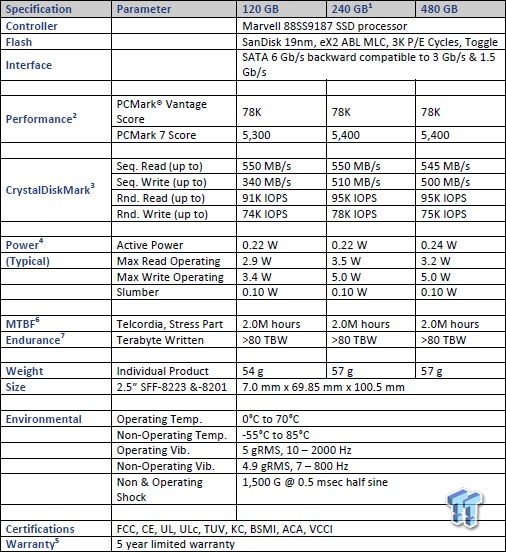
The SanDisk Extreme II starts shipping today and in three capacity sizes - 120GB, 240GB and 480GB. Many of us would love to see a 960GB version, but SanDisk chose to leave a massive capacity size model off the table, at least for now. At the heart of Extreme II is a Marvell 88SS9187 controller with custom SanDisk firmware. Paired with the 9187 is SanDisk's 19nm MLC Toggle flash rated for 3K P/E cycles.
In a move designed to set a new standard, or to rebut the old ways, SanDisk used CrystalDiskMark to determine the marketing performance numbers. For years, ATTO and IOMeter was used to come up with marketing performance results, but over time companies moved away from the default ATTO tests (QD4), and IOMeter can be manipulated with compressible or incompressible results. To stop any confusion, SanDisk chose to use CDM for their marketing materials, since it's easy to run and a free application.
With that explanation out of the way, let's look at the specs. The 480GB Extreme II delivers 545MB/s sequential read performance and 500MB/s sequential write performance. IOPS performance comes in at 95K read and 75K write. The 240GB capacity size is the fastest in the Extreme II product family, but the 480GB model is only just behind. This is a sharp contrast to the original Extreme where the 480GB model had a sharp drop off in performance when compared to the 240GB model.

Each capacity size ships in two flavors, a Notebook version with a 7mm to 9.5mm adapter and a full Desktop Upgrade Kit with a desktop adapter bracket, SATA cable and mounting screws. Extreme II also has a five year warranty.
Just days before going live with the reviews, we received word about pricing. SanDisk's MSRP for the 120GB Extreme II is $129.99, 240GB is $229.99 and the 480GB is $439.99.
SanDisk Extreme II 480GB

SanDisk delivered three drives, one of each capacity size, but we didn't receive the retail package to show today. We don't expect much of a change from the Ultra Plus or original Extreme. This is a 7mm z-height product with a metal base and a plastic top cover.

The capacity size, model and serial number are all located on the back of the drive.

The 7mm z-height, 2.5" form factor uses the same mounting points on the bottom and sides as traditional notebook drives that are 9.5mm tall.

The SATA power and data connectors are also the same as standard notebook drives. The Extreme II will fit in your notebook and many ultrabooks without issue. Desktop users can purchase the Desktop Replacement Kit and receive a desktop adapter bracket that puts the drive in a standard 3.5" HDD bay.
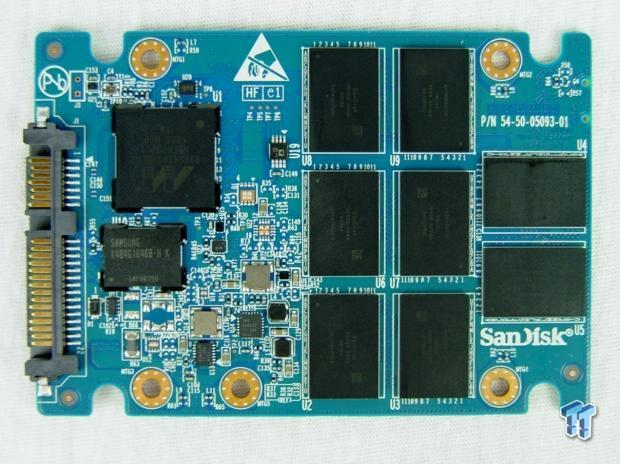
Here we get our first real shot of the SanDisk Extreme II. Unlike the 120GB model, the 240GB and 480GB populate all eight of the flash pads. Each NAND chip, the controller and the DRAM module all get a thermal pad to help transfer heat to the 7mm metal housing.

Extreme II has many open pads on the back for large surface mount capacitors. These aren't used on Extreme II so we can't help but wonder what other products SanDisk has cooking in the lab with this PCB.

As we mentioned in the introduction, the Extreme II uses the Marvell 88SS9187 controller. This is an 8-channel design, the same used Plextor's M5 Pro and M5 Xtreme as well as Crucial's M500. It's a solid controller known for high performance when paired with quality NAND and well written firmware.

The 480GB size uses a Samsung DDR3 DRAM buffer that is 4GB in size.

In the 120GB Extreme II review posted earlier today, we talked about the SanDisk NAND quite a bit. In the 512GB class size, the flash has more interleaving, so SanDisk's architecture advantage shouldn't stand out as much. Let's dive right in and see how that theory works out.
Benchmarks - Test System Setup and ATTO Baseline Performance
Desktop Test System
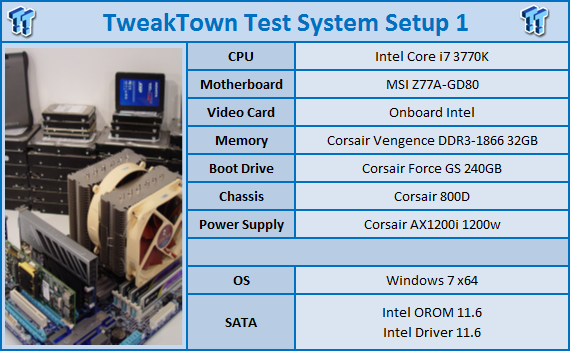
Lenovo W530 - Mobile Workstation
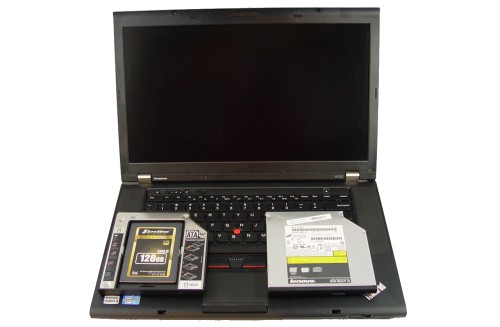
We use two systems for SSD testing. The desktop runs a majority of the tests and the Lenovo W530 runs the notebook power tests as well as the real-world file transfer benchmark.
ATTO Baseline Performance
Version and / or Patch Used: 2.34
ATTO is used by many disk manufacturers to determine the read and write speeds that will be presented to customers.

Just like the other capacity sizes we've tested today, which hopefully you read as well, peak performance doesn't come in at the largest block sizes. The 480GB Extreme II reaches peak reads at the 128K block size, just over 553MB/s. The peak write performance came in at the same block size. We measured peak write performance at 512MB/s.
Benchmarks - Sequential Performance
HD Tune Pro
Version and / or Patch Used: 4.00
Developer Homepage: http://www.efdsoftware.com
Product Homepage: http://www.hdtune.com
HD Tune is a Hard Disk utility which has the following functions:
Benchmark: measures the performance
Info: shows detailed information
Health: checks the health status by using SMART
Error Scan: scans the surface for errors
Temperature display
HD Tune Pro gives us accurate read, write and access time results and for the last couple of years has gained popularity amongst reviewers. It is now considered a must have application for storage device testing.
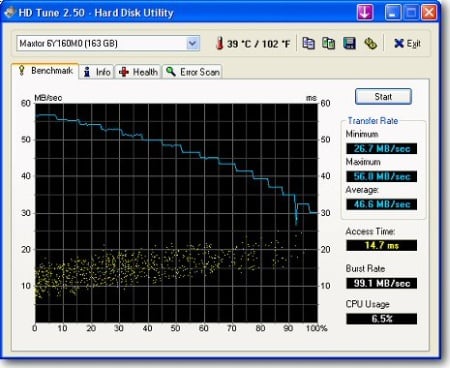

Also like the other capacity sizes, the SanDisk Extreme II makes its presence known on the charts right away. Extreme II 480GB pushed the sequential bar a little higher. I didn't really expect to see anything knock 840 Pro off the top step with SATA III since we're butting up against the real-world limits of SATA 6Gb, but Extreme II managed to raise the bar.

When writing sequential data, Vector is a little faster at peak, but the Extreme II has a slightly higher average write speed with this type of data.
HD Tach - Sequential Write Performance after Random Writes

After hitting the Extreme II 480GB with a realistic amount of random writes, we measured the sequential read and write performance again. Extreme II only drops below 200MB/s once in this test.
Benchmarks - AIDA64 Random Access Time
AIDA64 Random Access Time
Version and / or Patch Used: 1.60
Developer Homepage: http://www.aida64.com
Product Homepage: http://www.aida64.com
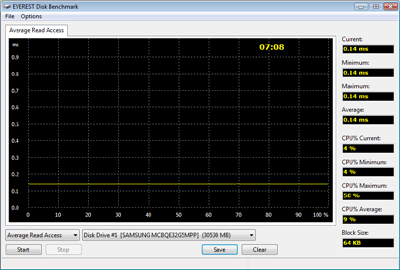
AIDA64 offers several different benchmarks for testing and optimizing your system or network. The Random Access test is one of very few if not only that will measure hard drives random access times in hundredths of milliseconds as oppose to tens of milliseconds.
Drives with only one or two tests displayed in the write test mean that they have failed the test and their Maximum and possibly their Average Scores were very high after the cache fills. This usually happens only with controllers manufactured by Jmicron.
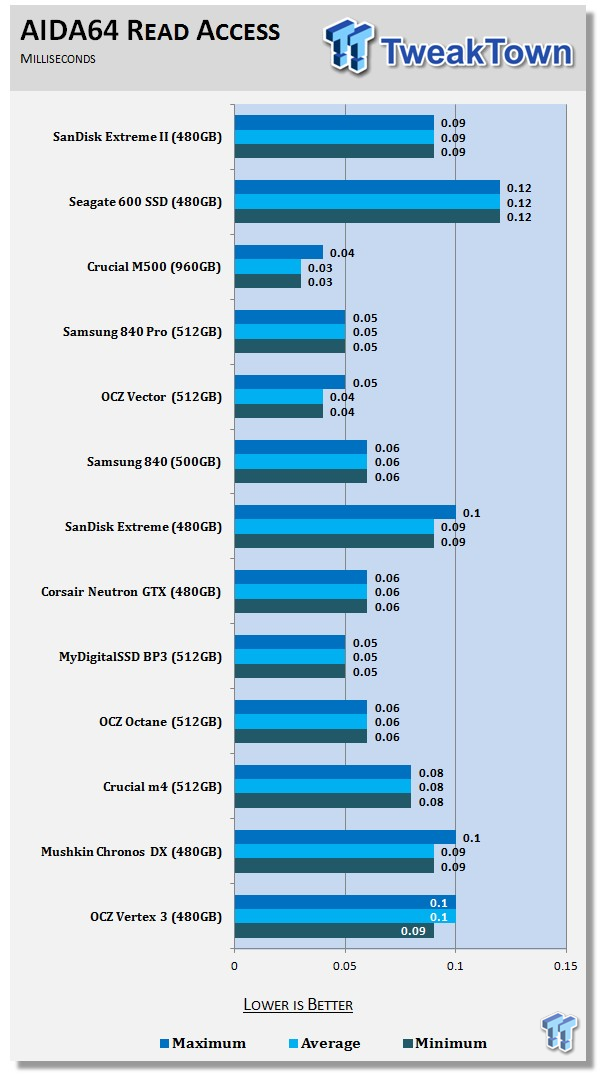
The read latency was steady in our AIDA64 test. We recorded .09ms, around the same as the other Extreme II capacity sizes.

In the AIDA64 write latency test we were able to see where the DRAM and SLC tiering crosses over. On the chart it shows up as erratic write latency, but in the benchmark, it shows as scaled planes.
Benchmarks - Anvil Storage Utilities
Anvil Storage Utilities
Version and / or Patch Used: RC6
So what is Anvil Storage Utilities? First of all, it's a storage benchmark for SSDs and HDDs where you can check and monitor your performance. The Standard Storage Benchmark performs a series of tests, you can run a full test or just the read or the write test or you can run a single test, i.e. 4K DQ16.
Anvil Storage Utilities is not officially available yet but we've been playing with the beta for several months now. The author, Anvil on several international forums has been updating the software steadily and is adding new features every couple of months.
The software is used several different ways and to show different aspects for each drive. We've chosen to use this software to show the performance of a drive with two different data sets. The first is with compressible data and the second data set is incompressible data. Several users have requested this data in our SSD reviews.
0-Fill Compressible Data
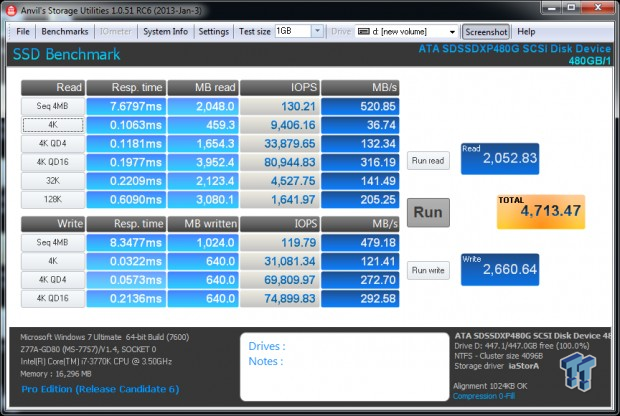
Incompressible Data

When comparing incompressible to compressible performance, we didn't notice a large difference moving between file types with Extreme II.
Read IOPS through Queue Depth Scale

To get big sensational marketing numbers, companies publish their high queue depth IOPS results. In the real-world, desktop users rarely achieve a queue depth higher than 4 and because of that we built our scaling IOPS charts.
True to the results we achieved with the Extreme II in other capacity sizes, the 480GB fits right in between Samsung's 840 Po and OCZ's Vector SSDs in the QD1 test. Extreme II 480GB and 840 Pro went back and forth up the depth scale with the Vector following close behind.
Scaling Write IOPS through Queue Scale

OCZ's Vector has amazing write IOPS at low queue depths and takes the lead in this test. Again Extreme II splits the two other hyper speed SSDs on the market. Oddly enough, after all of our ranting about 20nm write performance in the previous two reviews published today, Crucial managed to break into the top tier in this test.
As we stated in the other articles, if you want to get performance out of 20nm, you need ramp up the capacity size to get a lot of interleaving. Extreme II did well though all the way up to QD4. The drive doesn't scale much after QD4, but it's not an issue for desktop consumer users.
Benchmarks - CrystalDiskMark
CrystalDiskMark
Version and / or Patch Used: 3.0 Technical Preview
Developer Homepage: http://crystalmark.info
Product Homepage: http://crystalmark.info/software/CrystalDiskMark/index-e.html
Download here: http://crystaldew.info/category/software/crystaldiskmark
CrystalDiskMark is a disk benchmark software that allows us to benchmark 4K and 4K queue depths with accuracy.
Key Features:-
* Sequential reads/writes
* Random 4KB/512KB reads/writes
* Text copy
* Change dialog design
* internationalization (i18n)
Note: Crystal Disk Mark 3.0 Technical Preview was used for these tests since it offers the ability to measure native command queuing at 4 and 32.
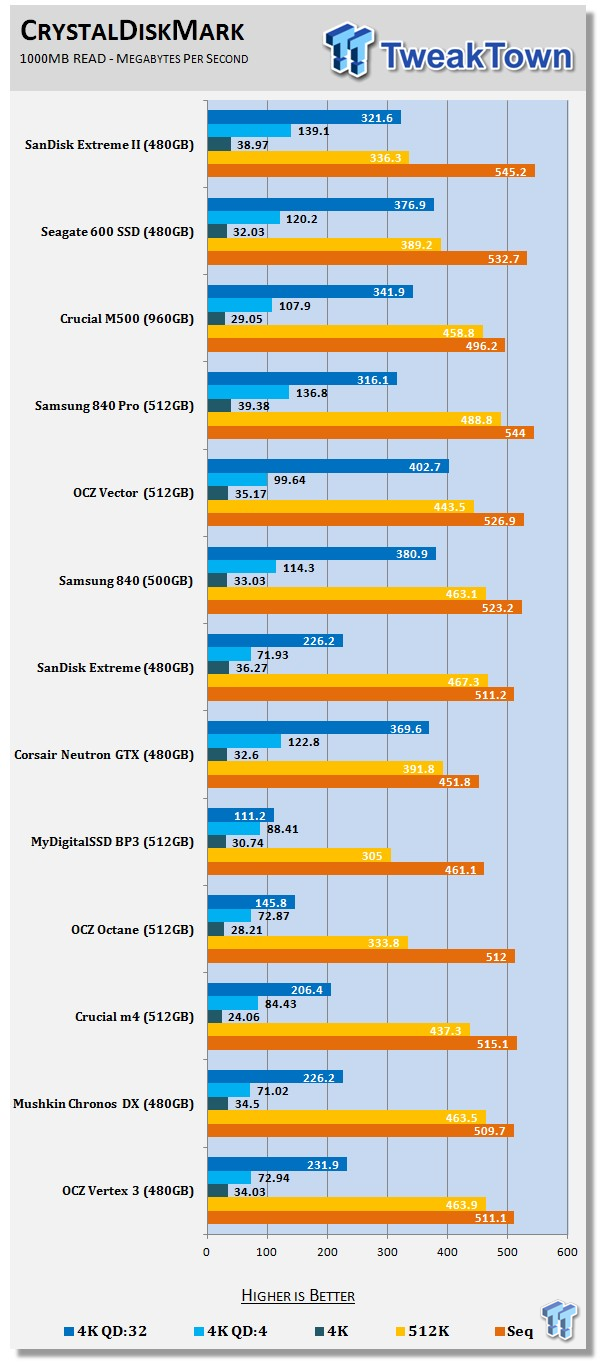
When you test SSDs for a living, you find little benchmarks inside of benchmarks, targets to look for that help determine performance across the broad range of applications. We've only had three consumer SSDs hit 40MB/s in CDM's 4K read. The Samsung 840 Pro in 128GB and 256GB capacity size and the Chris Ramseyer Signature Edition 128GB SSD. The SanDisk Extreme II in all capacity sizes gets very close to 40MB/s in this test, knocking on the door of 39MB/s in all capacity sizes.

Further down the chart you'll find the original Extreme SSD from SanDisk. In the 480GB capacity size the 4K performance is much lower than the Extreme II. The architecture on the original lacks a DRAM cache for buffing page table data. When you start mapping 512GB of information, the DRAM buffer comes in handy.
Benchmarks - PCMark Vantage Hard Disk Tests
PCMark Vantage - Hard Disk Tests
Version and / or Patch Used: 1.0.0
Developer Homepage: http://www.futuremark.com
Product Homepage: http://www.futuremark.com/benchmarks/pcmark-vantage/

PCMark Vantage is the first objective hardware performance benchmark for PCs running 32 and 64 bit versions of Microsoft Windows Vista. PCMark Vantage is perfectly suited for benchmarking any type of Microsoft Windows Vista PC from multimedia home entertainment systems and laptops to dedicated workstations and high-end gaming rigs. Regardless of whether the benchmarker is an artist or an IT Professional, PCMark Vantage shows the user where their system soars or falls flat, and how to get the most performance possible out of their hardware. PCMark Vantage is easy enough for even the most casual enthusiast to use yet supports in-depth, professional industry grade testing.
FutureMark has developed a good set of hard disk tests for their PCMark Vantage Suite. Windows users can count on Vantage to show them how a drive will perform in normal day to day usage scenarios. For most users these are the tests that matter since many of the old hat ways to measure performance have become ineffective to measure true Windows performance.

HDD1 - Windows Defender
HDD2 - Gaming
HDD3 - Windows Photo Gallery
HDD4 - Vista Startup
HDD5 - Windows Movie Maker
HDD6 - Windows Media Center
HDD7 - Windows Media Player
HDD8 - Application Loading
The lower queue depth performance and sequential performance come together in Vantage to deliver very high yet balanced results in all tests. Extreme II manages to outperform every other drive in a few of the tests, but is competitive in the other tests, which is just as important.
Benchmarks - PCMark Vantage - Drives with Data Testing
For a complete breakdown on the Drives with Data Testing please read this article. You will be able to perform this test at home with the files provided in the article - full instructions are included.
- Brief Methodology
SSDs perform differently when used for a period of time and when data is already present on the drive. The purpose of the Drives with Data testing is to show how a drive performs in these 'dirty' states. SSDs also need time to recover, either with TRIM or onboard garbage collection methods.
Drives with Data Testing - 25%, 50%, 75% Full States and Dirty / Empty Test
Files needed for 60 (64GB), 120 (128GB), 240 (256GB)
60GB Fill - 15GB, 30GB, 45GB
120GB Fill - 30GB, 60GB, 90GB
240GB Fill - 60GB, 120GB, 160GB
Empty but Dirty - a test run just after the fill tests and shows if a drive needs time to recover or if performance is instantly restored.

The reason why we wrote full reviews for each capacity size is so we could show the performance of equal capacity size drives for each Extreme II capacity class.
The 120GB and 240GB Extreme II faired a bit better in the data on disk testing in relation to the other 512GB class products. The 480GB Extreme II still performed very well here, but in this capacity size, it's not as competitive as the 840 Pro 512GB.
Benchmarks - BootRacer
BootRacer - System Boot Time
Version and / or Patch Used: 4.0
Developer Homepage: Greatis
Product Homepage: BootRacer
Download here: http://www.greatis.com/bootracer/download.htm
Note: In this test we use the Lenovo W530 Mobile Workstation loaded with an operating system and several program files. The data on the drive at the time of the test is 45GB. The second test, 50GB Free, was ran with the drives filled with block data until only 50GB of free capacity remained.
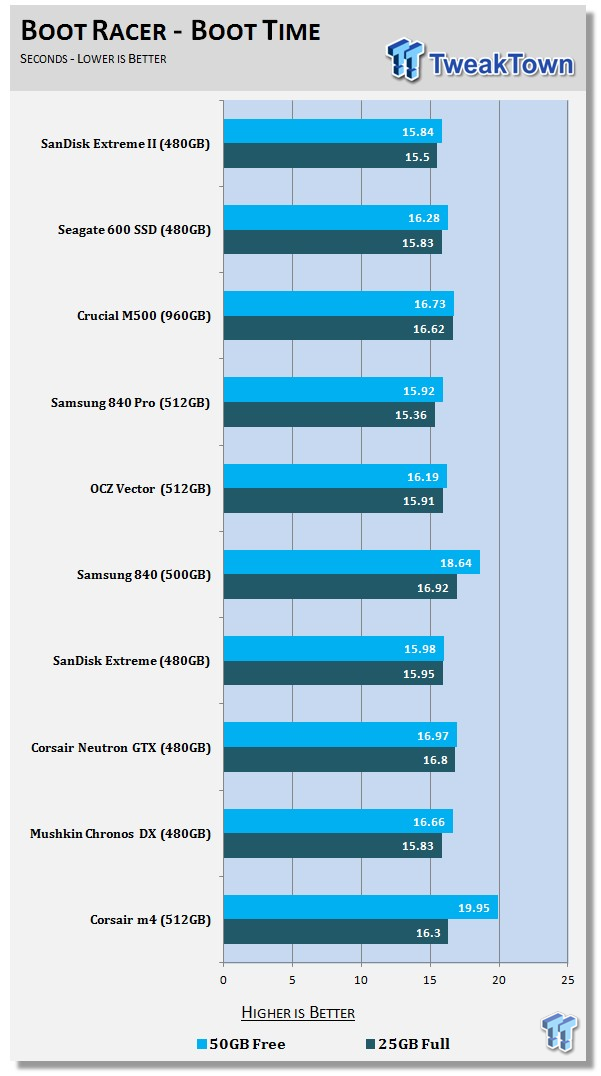
Our Lenovo W530 workstation isn't the fastest booting notebook on the market, so nearly all of the performance SSDs in our chart produce roughly the same reboot results. It is nice to see how additional data on the flash affects performance in a real, real-world test though.
When our new Haswell notebooks arrive this test will get cut and replaced by a custom wake from DEVSLP test.
Benchmarks - DiskBench
DiskBench - Directory Copy
Version and / or Patch Used: 2.6.2.0
Developer Homepage: Nodesoft
Product Homepage: DiskBench
Download here: http://www.nodesoft.com/diskbench/download
Note: In this test we use the Lenovo W530 Mobile Workstation and a SuperSSpeed S301 SLC 128GB SSD to move a 15GB block of data to and from the target drive. This is part of our real-world test regiment. Roughly 45GB of data resides on the target drive before the '15GB Block' is transfer. The 15GB Block is the same data we built for the Data on Disk Testing and is a mix of compressible and incompressible data.

As the drive capacity increases, the relevance of our custom directory copy performance test increases. With larger drives you have the ability to transfer larger files.
A 20MB file will still take about the same time as it does on a 128GB SSD, but with 512GB of flash available, you can keep 700MB FLAC files on your drive. On a smaller SSD, you may want to keep MP3 files instead, because of the capacity limits. Larger SSDs enhance other areas of the user experience outside of storage speed.
Benchmarks - Power Testing
Bapco MobileMark 2012 1.5
Version and / or Patch Used: 2012 1.5
Developer Homepage: http://www.bapco.com
Test Homepage: http://www.bapco.com
MobileMark 2012 1.5 is an application-based benchmark that reflects usage patterns of business users in the areas of office productivity, media creation and media consumption. Unlike benchmarks that only measure battery life, MobileMark 2012 measures battery life and performance simultaneously, showing how well a system design addresses the inherent tradeoffs between performance and power management.
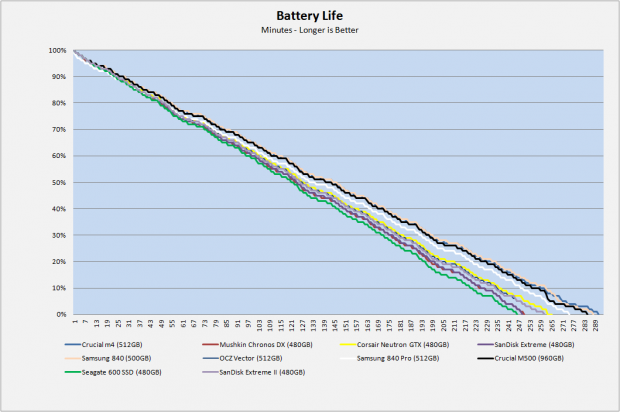
This is another test where we needed to show performance with equal capacity size products.
The 240GB Extreme II did really well compared to other equal sized SSDs in our notebook battery test. The Extreme II 480GB, well... not so much.
PCMark Vantage HDD Test - Power Draw

Even after looking at the power consumption in our trace test, I can't explain why the Extreme II 480GB delivers less battery life than the other capacity sizes. I suspect the answer rests with the DRAM buffer, though.
The 240GB Extreme II uses a Hynix 2GB and the 480GB uses a Samsung 4GB DRAM buffer. DRAM uses more power than NAND and produces more heat. Additional heat close to the notebook processor and video chip would lead to additional power consumption from the fans, so heat alone can reduce battery time.
Final Thoughts

We haven't talked much about the SanDisk Extreme II 480GB price, but when it comes to these large capacity size SSDs, I feel the price is a bit more important than the other capacity sizes. SanDisk's MSRP is $439.99 and that's where we expect Newegg to be on launch day. In this capacity size, we can wipe every LSI SandForce SSD off the table due to low 4K write performance, unless you are just looking for a really low-cost 512GB class SSD. The Corsair Force GS 480GB costs $319.99 at Newegg and the original Extreme 480GB is $359.99, but as we stated, the 4K performance is down on these products.
The Samsung 840 (non-Pro) comes up at $329.99 at Newegg. The 840 is fast, but not in the top tier hyper-class fast like 840 Pro ($499.99) and Vector ($539.99). The Sandisk Extreme II 480GB rounds out this hyper-class of performance SSDs, the best of the best in performance terms, and it also costs less than the other two drives in this very limited group. As mentioned, I feel price plays a very big role in the purchasing decision in this capacity size. With an average of around $500, well that's a lot of loot that could go towards a lot of different things. It is real money and not weekend concert or a couple of nights out with the boys at the bar money. Extreme II eases the wallet pain and delivers top tier performance at a much lower price.
When it comes to performance, the Extreme II is like smacking a racehorse with the jockey stick. In our testing, the Extreme II 480GB came alive and delivered great performance. For desktop use, it doesn't have any weaknesses.
In a notebook tied to a wall, we can still recommend this product, but if you spend a lot of time on battery, the Extreme II 480GB won't deliver the same battery life as the 240GB model. In our test with a six-cell battery, the time difference was around 35 minutes. With a larger 9-cell battery, we estimate the difference to be closer to 50 minutes and in an ultrabook where 10-hour battery time is possible, the difference could be as high as an hour and a half to two hours.
As a performance SSD, the SanDisk Extreme II 480GB delivers the two things we want most - high performance, with a good price.

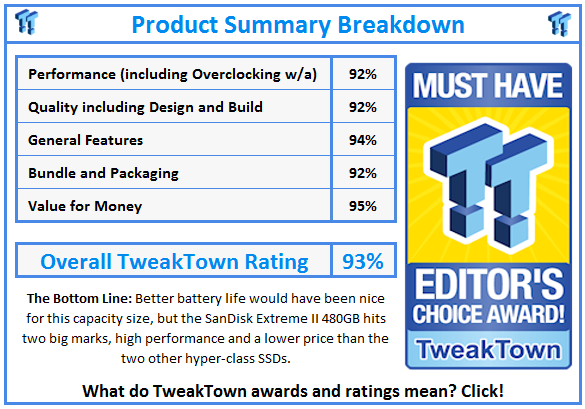
 United
States: Find other tech and computer products like this
over at
United
States: Find other tech and computer products like this
over at  United
Kingdom: Find other tech and computer products like this
over at
United
Kingdom: Find other tech and computer products like this
over at  Australia:
Find other tech and computer products like this over at
Australia:
Find other tech and computer products like this over at  Canada:
Find other tech and computer products like this over at
Canada:
Find other tech and computer products like this over at  Deutschland:
Finde andere Technik- und Computerprodukte wie dieses auf
Deutschland:
Finde andere Technik- und Computerprodukte wie dieses auf